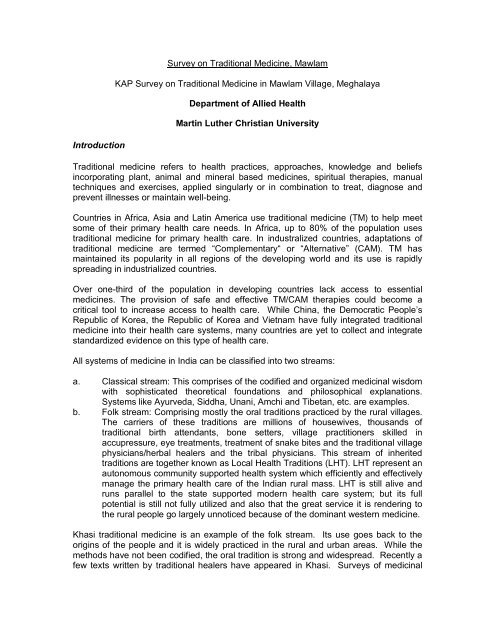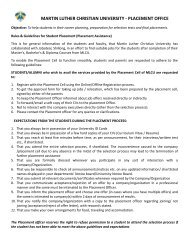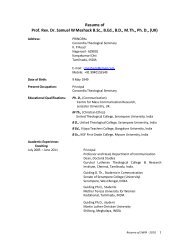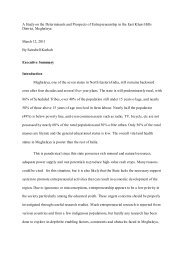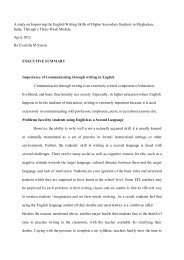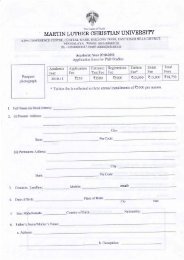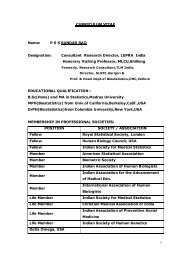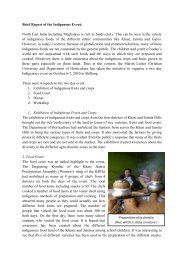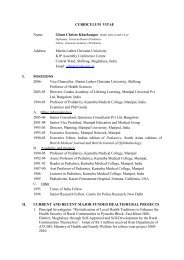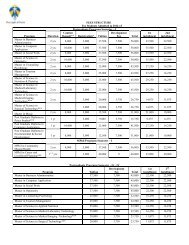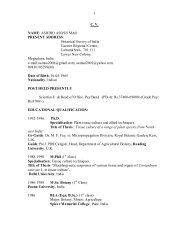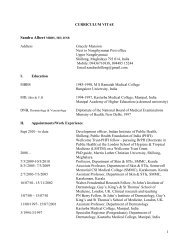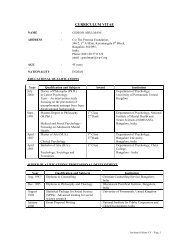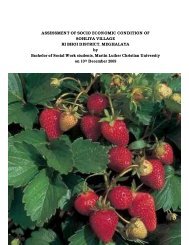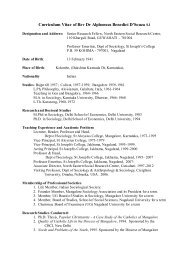to read more - Martin Luther Christian University
to read more - Martin Luther Christian University
to read more - Martin Luther Christian University
- No tags were found...
You also want an ePaper? Increase the reach of your titles
YUMPU automatically turns print PDFs into web optimized ePapers that Google loves.
Introduction<br />
Survey on Traditional Medicine, Mawlam<br />
KAP Survey on Traditional Medicine in Mawlam Village, Meghalaya<br />
Department of Allied Health<br />
<strong>Martin</strong> <strong>Luther</strong> <strong>Christian</strong> <strong>University</strong><br />
Traditional medicine refers <strong>to</strong> health practices, approaches, knowledge and beliefs<br />
incorporating plant, animal and mineral based medicines, spiritual therapies, manual<br />
techniques and exercises, applied singularly or in combination <strong>to</strong> treat, diagnose and<br />
prevent illnesses or maintain well-being.<br />
Countries in Africa, Asia and Latin America use traditional medicine (TM) <strong>to</strong> help meet<br />
some of their primary health care needs. In Africa, up <strong>to</strong> 80% of the population uses<br />
traditional medicine for primary health care. In industralized countries, adaptations of<br />
traditional medicine are termed “Complementary“ or “Alternative” (CAM). TM has<br />
maintained its popularity in all regions of the developing world and its use is rapidly<br />
sp<strong>read</strong>ing in industrialized countries.<br />
Over one-third of the population in developing countries lack access <strong>to</strong> essential<br />
medicines. The provision of safe and effective TM/CAM therapies could become a<br />
critical <strong>to</strong>ol <strong>to</strong> increase access <strong>to</strong> health care. While China, the Democratic People’s<br />
Republic of Korea, the Republic of Korea and Vietnam have fully integrated traditional<br />
medicine in<strong>to</strong> their health care systems, many countries are yet <strong>to</strong> collect and integrate<br />
standardized evidence on this type of health care.<br />
All systems of medicine in India can be classified in<strong>to</strong> two streams:<br />
a. Classical stream: This comprises of the codified and organized medicinal wisdom<br />
with sophisticated theoretical foundations and philosophical explanations.<br />
Systems like Ayurveda, Siddha, Unani, Amchi and Tibetan, etc. are examples.<br />
b. Folk stream: Comprising mostly the oral traditions practiced by the rural villages.<br />
The carriers of these traditions are millions of housewives, thousands of<br />
traditional birth attendants, bone setters, village practitioners skilled in<br />
accupressure, eye treatments, treatment of snake bites and the traditional village<br />
physicians/herbal healers and the tribal physicians. This stream of inherited<br />
traditions are <strong>to</strong>gether known as Local Health Traditions (LHT). LHT represent an<br />
au<strong>to</strong>nomous community supported health system which efficiently and effectively<br />
manage the primary health care of the Indian rural mass. LHT is still alive and<br />
runs parallel <strong>to</strong> the state supported modern health care system; but its full<br />
potential is still not fully utilized and also that the great service it is rendering <strong>to</strong><br />
the rural people go largely unnoticed because of the dominant western medicine.<br />
Khasi traditional medicine is an example of the folk stream. Its use goes back <strong>to</strong> the<br />
origins of the people and it is widely practiced in the rural and urban areas. While the<br />
methods have not been codified, the oral tradition is strong and widesp<strong>read</strong>. Recently a<br />
few texts written by traditional healers have appeared in Khasi. Surveys of medicinal
plants and some labora<strong>to</strong>ry investigations have been conducted in various academic<br />
institutions in the state.<br />
Aim of the study<br />
The aim of this study was <strong>to</strong> evaluate the knowledge, attitudes and practices (KAP) of<br />
the people of Mawlam village which is located in Pynursla Block of the East Khasi Hills<br />
District of Meghalaya. The village has a population of approximately 900, with<br />
approximately 200 households.<br />
Methods<br />
A KAP questionnaire was designed, translated in<strong>to</strong> Khasi and pre-tested as a<br />
biostatistics class project of the department of allied health of <strong>Martin</strong> <strong>Luther</strong> <strong>Christian</strong><br />
<strong>University</strong>. 80 households were randomly selected and teams of two students each<br />
administered the questionnaire <strong>to</strong> an adult in the household. The survey was conducted<br />
on March 8, 2007.<br />
Results<br />
In 23 of the 80 questionnaires filled out, many questions were unanswered so 57 were<br />
analysed. The following results were obtained:<br />
A. Demographic profile of respondents:<br />
Sex of respondents: F 49 M 8<br />
Age of respondents: Range 13-80 years<br />
Mean 36 years<br />
SD<br />
16 years<br />
Education: No education 35<br />
Class 1-3 13<br />
Class 4-7 9<br />
Occupation: Farmer 24<br />
Labourer 14<br />
Broom making 10<br />
Other 13<br />
B. Responses <strong>to</strong> questions<br />
1. Do you use traditional remedies at home<br />
Yes 17<br />
No 36<br />
Total 53
2. Can you give 2-3 examples<br />
Yes 5 No 23<br />
3. Is there a traditional healer(s) in the area<br />
Yes 40<br />
No 7<br />
Don’t 6<br />
know<br />
Total 53<br />
4. Can you give the names of one or two<br />
24 gave names<br />
5. Are they full-time or part-time<br />
Fulltime<br />
6<br />
Parttime<br />
25<br />
Don’t 10<br />
know<br />
Total 41<br />
6. Are traditional healers popular<br />
Yes 21<br />
No 10<br />
Don’t 10<br />
know<br />
Total 41<br />
7. Is the use of traditional healers decreasing<br />
Yes 18<br />
No 9<br />
Don’t 13<br />
know<br />
Total 40
8. Can you name some medicinal plants<br />
Yes 8<br />
No 10<br />
Don’t 20<br />
know<br />
Total 38<br />
9. Do the healers use medicinal plants<br />
Yes 23<br />
No 2<br />
Don’t 12<br />
know<br />
Total 37<br />
10. Do the healers use non-herbal treatments<br />
Yes 11<br />
No 11<br />
Don’t 15<br />
know<br />
Total 37<br />
Can you give 1-2 examples of non-herbal treatments<br />
Yes 1 Animal fat<br />
11. Traditional medicine treatments are affordable<br />
Yes 33<br />
No 5<br />
Don’t 6<br />
know<br />
Total 44<br />
12. Traditional medicine is good<br />
Yes 32<br />
No 3<br />
Don’t 15<br />
know<br />
Total 50<br />
13. Traditional medicines are better than allopathic medicines<br />
Yes 10<br />
No 19<br />
Don’t 24<br />
know<br />
Total 53
14. Traditional medicines are cheaper than allopathic medicines<br />
Yes 43<br />
No 3<br />
Don’t 7<br />
know<br />
Total 53<br />
15. Traditional healers should be recognized by the government<br />
Yes 8<br />
No 8<br />
Don’t 29<br />
know<br />
Total 45<br />
16. How many times in the last year has a family member consulted a traditional<br />
healer<br />
1-4 times 13 5+ 2 Many 8 DK 7<br />
17. Members of the family for which traditional medicine was taken.<br />
Children 26<br />
Adults/elders 13<br />
Pregnant 4<br />
18. What formulations of traditional medicine were taken<br />
Powder 5<br />
Liquid 27<br />
Ointment 14<br />
19. How much money was spent on traditional healers last year<br />
Up <strong>to</strong> Rs 100 11<br />
Rs 100-500 9<br />
Above Rs 500 0<br />
Not much 2<br />
DK 3
20. How many times in the last year has a family member consulted an allopathic<br />
doc<strong>to</strong>r<br />
Up <strong>to</strong> 10 visits 18<br />
More than 10 1<br />
Many times 13<br />
Sometimes 1<br />
21. For which family members were allopathic treatments taken<br />
Children 28<br />
Adults/elders 20<br />
Pregnant 12<br />
22. For what type of illnesses do family members go <strong>to</strong> an allopathic doc<strong>to</strong>r<br />
Minor illnesses 9<br />
Major illnesses 18<br />
Check-up 2<br />
All/other 7<br />
Failure of TM 2<br />
23. How much money was spent on allopathic treatments in the last one year<br />
Up <strong>to</strong> Rs 100 1<br />
Rs 100-999 11<br />
Rs 1000+ 6<br />
Rs 3000+ 8<br />
DK 4<br />
More than TM 1<br />
Lots 1<br />
24. Types of illnesses for which TM was sought<br />
Eye problems 3<br />
Flu 3<br />
Chest pain 1<br />
Dysentery 1<br />
Skin 1<br />
Fever 1<br />
Constipation 1<br />
Kidney 1<br />
Mild stroke 1<br />
Child diarrhea 1<br />
Gastric<br />
1<br />
Whoop cough 1<br />
25. Average expenditure on traditional and allopathic medicine in the last one year.<br />
Traditional medicine Rs 160<br />
Allopathic medicine Rs 2100
Discussion<br />
The majority of the respondents were women, indicating perhaps that the menfolk were<br />
at work, as the survey was conducted during the day. The education level of the<br />
respondents could provide an indication of the educational status of the women in the<br />
village. Most of the households appear <strong>to</strong> have occupations that are unskilled or semiskilled.<br />
A majority of the respondents are familiar with traditional medicine, could name a local<br />
traditional healer and had some knowledge of their type of practice and their use of<br />
medicinal plants. Many households had consulted and used the services of traditional<br />
healers, occasionally or frequently during the previous one year, mainly for minor<br />
illnesses, especially for children.<br />
Most of the respondents felt that traditional medicine is good and economical. Most of<br />
the respondents also used allopathic medicine services, especially for major illnesses for<br />
all members of the family. The expenditure on allopathic medicine was considerable<br />
higher than for traditional medicine.<br />
Conclusions and recommendations<br />
Traditional medicine is respected and widely used in the rural areas of Meghalaya.<br />
Allopathic services are also used but may not be convenient <strong>to</strong> access and is also<br />
expensive. Traditional medicine should be encouraged, especially in rural areas as it<br />
contributes substantially <strong>to</strong> primary health care. The government should consider<br />
integrating traditional medicine in<strong>to</strong> the formal health system of the state. Two<br />
cautionary provisions are recommended. Firstly, the conservation of animals and plants<br />
should be kept in mind in the preparation of folk medicinal preparations. Secondly, there<br />
should be a method of evaluating the knowledge and expertise of the folk healers.<br />
References<br />
www.who.org<br />
www.indianmedicine.nic.in<br />
Acknowledgements<br />
The survey and analysis was conducted by the following allied health students:<br />
Eddie O. Lyngdoh<br />
Archieson Lyngdoh<br />
Alleysha Syiemlieh<br />
Balajied Iawphniaw<br />
Grace Cia Bell Sna<br />
Banshanhi I. Nongkhlaw<br />
Nengneilhing Hangshing<br />
Dakaruhipaya War<br />
Deepa Lamin Khonglah<br />
Tifully Sohkhlet<br />
Bahunlang Dhar<br />
Lalonging M. Lyngdoh<br />
Persara Kharjana<br />
Baiadapdor Diengdoh<br />
Frieda M. Umlong<br />
Khonzani A. Nguillie<br />
Melbourne Marbaniang<br />
James Maitphang Suchen<br />
Fearless Ryngksai<br />
Lurstep Phyrnai Mawlong
Pynhunlin Lyngdoh<br />
Pynshailang Mukhim<br />
Rymphanglin Jyrwa<br />
Biak Lura Kaipeng<br />
Hopingstar Shylla<br />
Madelson Slong<br />
Evawanda N. C. Syiem<br />
George Glarius Marbaniang<br />
Dolly Marak<br />
Baleisha Kurbah<br />
Wanbianghimo T. Nongrum<br />
Mayreen Ryngksai<br />
Ritika C. Kharkongor<br />
Balasara H. Jyrwa<br />
Iaisankyrhai Nongkynrih<br />
Mar Leki Pohlong<br />
Lapyntngenlin L. Nonglait<br />
Rilangmiki Dkhar<br />
Glorisha Lyngdoh<br />
Nivan Yoo War<br />
Ibalabynta Syiem<br />
Silver Bell Shylla<br />
Banshembha Kharumnuid<br />
Samborlang Wankhar<br />
Neil Robert Wahlang<br />
Dashisha Paliar<br />
Rudalangki Shylla<br />
Moffida Patweth<br />
Richmond Suna<br />
Carefulness Tiewsoh<br />
Isabel Kurkalang<br />
Imondaris Nongrem
The teacher facilita<strong>to</strong>rs: R Jennifer War, Bonnie M Nicol, Wadamika Lyngdoh<br />
The instruc<strong>to</strong>r for the course: Glenn C Kharkongor


